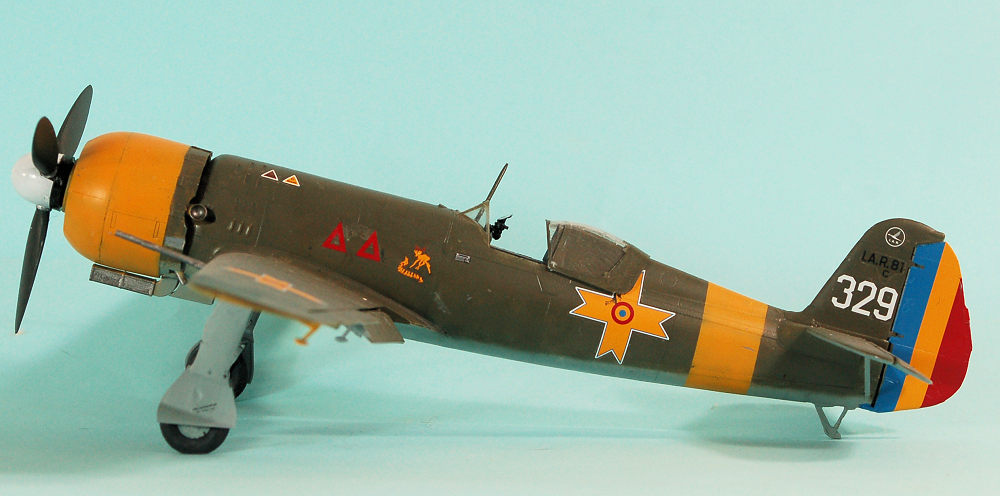
Special Hobby 1/32 IAR-81C
| KIT #: | SH 32068 |
| PRICE: | @$75.00 shipped from various vendors |
| DECALS: | Four options |
| REVIEWER: | Tom Cleaver |
| NOTES: |

| HISTORY |
Dawn, June 10, 1944. The great complex of air bases near Foggia, Italy, bustles with activity as the sun rises. Forty-six Lockheed P-38J "Lightnings" of the 82nd Fighter Group - composed of the 95th, 96th, and 97th Fighter Squadrons - each carrying a 1000 lb bomb on the right wing shackle and a 310-gallon ferry drop tank on the left, shake the Foggia No. 11/Vincenzo airfield as they taxi for takeoff. Over the Adriatic, they will be joined by forty-eight P-38J's of the 1st Fighter Group - the 27th, 71st, and 94th Fighter Squadrons - flying as escort. One after another over southern Italy, nearly 100 P-38s take wing and climb to altitude. Their target: Ploesti, the major oil refinery complex in Europe, more than 600 miles away across the Adriatic Sea and over the mountains of Yugoslavia. The mission: to dive-bomb the Romano-Americano oil refinery, the major producer of high-grade aviation gasoline for the Luftwaffe and its allied air forces. It will be recorded as the blackest day in the history of the American fighter forces in the entire Second World War.
The primary defense of Ploesti was now the responsibility Grupul 6, equipped with I.A.R. 80/81 fighters, occasionally joined by Grupul 1 with Bf-109s. In total, the defenders had no more than 30 Bf-109s and 70 I.A.R. 80s; the I.A.R. 80 - the only domestically-designed Rumanian fighter to see service during the war - was thoroughly obsolete when compared to the P-51 Mustangs and P-38 Lightnings flown by their American opponents. The cannon-armed I.A.R.81C was particularly effective against the bombers and in the eight raids flown against Ploesti between April 5 and June 6, 1944, the attackers averaged an unacceptably-heavy 7% loss rate. Because of the tenacity of the defense and the effectiveness of the smoke generators based around the oil fields, the most valuable target - the Romano-Americano Oil Refinery - had escaped serious damage. It was too important to leave alone - something different had to be tried in the effort to knock out the refinery.
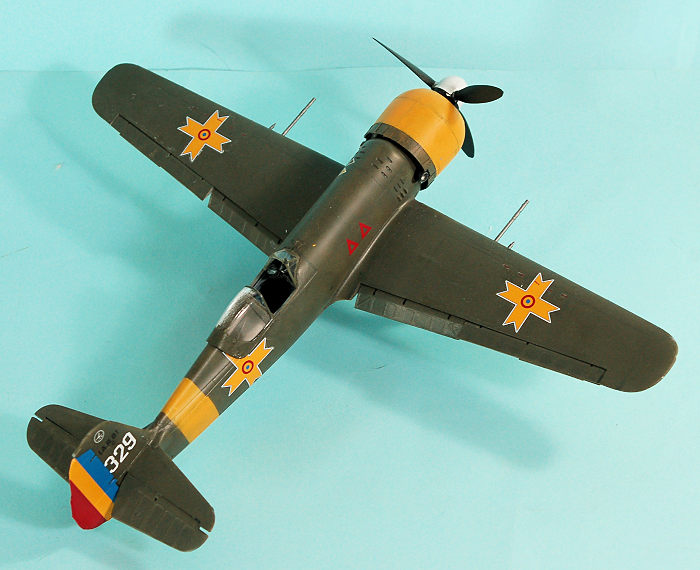 Among the pilots of the 96th Fighter Squadron detailed for the attack on
Romano-Americano was Captain Richard "Dick" Willsie, the Squadron Operations
Officer, an experienced pilot with more than 40 missions under his belt at the
time. "For whatever reason, that refinery led a charmed life," he recalled. "So
some bright guy at headquarters decided since the heavies couldn't hit it from
25,000 feet, that we were going to dive-bomb it from 10,000 feet. We had been
practicing this on an island off the Italian coast for a week, and felt we were
good enough at it we had a chance of being successful." Willsie by that time had
been flying with the 82nd for nearly a year, and was the senior man in the
squadron in missions flown.
Among the pilots of the 96th Fighter Squadron detailed for the attack on
Romano-Americano was Captain Richard "Dick" Willsie, the Squadron Operations
Officer, an experienced pilot with more than 40 missions under his belt at the
time. "For whatever reason, that refinery led a charmed life," he recalled. "So
some bright guy at headquarters decided since the heavies couldn't hit it from
25,000 feet, that we were going to dive-bomb it from 10,000 feet. We had been
practicing this on an island off the Italian coast for a week, and felt we were
good enough at it we had a chance of being successful." Willsie by that time had
been flying with the 82nd for nearly a year, and was the senior man in the
squadron in missions flown.
"There were 46 of us with bombs, and 48 escorts from the First Fighter Group," Willsie explained. "The strategy was we would join up while crossing the Adriatic and fly over Yugoslavia till we got to the mountains, at which point we would go into Romania on the deck - and I mean we were to remain at 50 to 100 feet altitude when we came out of the mountains."
Low-level formation flying is difficult under the best circumstances, let alone when two three-squadron formations are flying on the deck under radio silence for two-and-a-half hours. Unfortunately for the Americans, the German air defense radars had spotted them over Yugoslavia before they entered Rumanian airspace. This negated the value of the difficult low-level penetration, since they had lost the element of surprise. To cap things off, shortly after coming out of the mountains, the two groups became separated. The groups accelerated into their attack as they punched off their drop tanks over the farm fields.
With the radar reports now definite regarding the American attack, Luftwaffe Oberst Eduard Neumann, in overall command of the air defense forces, and his assistant controller, Capitan Comandor Aviator Gheorghe Miclescu of the Rumanian Air Force, scrambled their defenders as the P-38s spread out over the Rumanian plain. At this point, the Germans - having identified the attackers as jabos - were expecting an attack on their airfields.
All operational I.A.R.81s of Grupul 6 - led by top ace Capitan Aviator Dan Vizante (15 kills) - lifted off Popesti-Leordeni airfield and clawed for altitude while the Bf-109Gs of Grupul 7 flew back from the Russian Front and the Messerschmitts of I/JG 53 and III/JG 77 rose from Pipera airbase, near Bucharest. Among the scrambling Luftwaffe experten were I/JG 53 Gruppenkommandeur Knight’s Cross holder Major Jürgen Harder (64 victories), Leutnant Rupert Weninger, Leutnant Erich Gehring, and Unteroffizier Willi Dreyer, each of whom would raise their scores this day.
Within minutes, Capitan
Vizante and Grupul 6 were in position.
Moments later, the P-38s of the 1st Fighter Group passed Popesti-Leordeni
airfield and spotted four Do-217s attempting to land. Three flights of the 71st
Fighter Squadron broke off to attack these aircraft. Moments later, they were
bounced by the diving I.A.R.81s of Grupul 6,
which the Americans misidentified as Fw-190s. Four P-38s went down in the first
pass as the others salvoed their drop tanks and tried to turn with the enemy.
All the advantages the heavy P-38 had over the lighter I.A.R.80 were cancelled
out in dogfights waged at altitudes between 100 and 300 feet. This battle
occurred in a shallow valley filled with over 40 aircraft, with airplanes
erratically trying to avoid each other, and many hitting the ground. An
indication of how hot the battle was is the fact two P-38s went down when they
hit the ground with their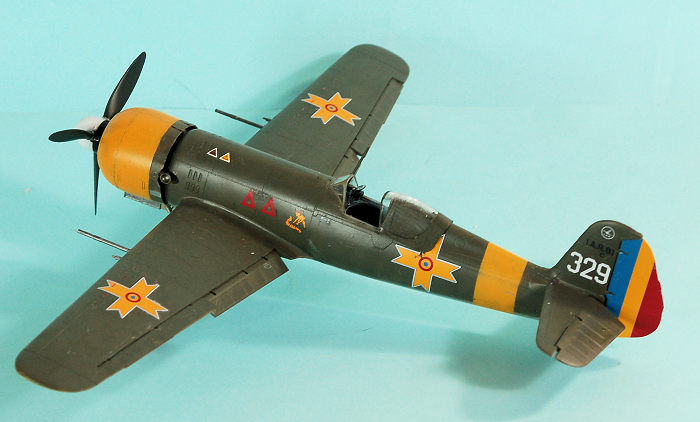 wingtips, while two I.A.R.81s collided over the field
and several others were hit by their own defensive groundfire.
wingtips, while two I.A.R.81s collided over the field
and several others were hit by their own defensive groundfire.
In the four minute battle, the 23 Rumanian pilots who made the interception claimed 23 P-38s for a loss of two of their own. The P-38s of the 71st Fighter Squadron suffered the highest casualties, losing nine of 16 pilots while 2nd Lt. Herbert "Stub" Hatch, Jr. - element lead for Cragmore Green flight - managed to shoot down five I.A.R.81s - the only Rumanian losses of the day - to make him one of few P-38 "aces in a day." Capitan Aviator Dan Vizante added two P-38s to his score to solidify his position as top I.A.R.81 ace of the Rumanian Air Force. Of the 23 P-38s claimed by the Romanians, the 1st Fighter Group lost a total of 14, with numerous others badly crippled.
The P-38s of the 1st Fighter Group, thoroughly routed by this effective interception, played no further part in the mission as the surviving pilots returned to Italy. The battle over Popesti-Leordeni would mark the high point of resistance by the Rumanian Air Force to the fighters of the 15th Air Force.
As this happened, the pilots of the 82nd Fighter Group overflew Pipera airbase as they approached Ploesti, looking for their missing escorts. Past the field, they began their climb to altitude to make the attack. At that moment, they were struck by the 40 Bf-109Gs of Grupul 7, I/JG 53 and III/JG 77.
"It was like the roof fell in on us," Willsie recalled. "There were 109s and heavy flak bursts everywhere." Of the 48 P-38s in the attack, only 24 were able to drop their bombs on the target, while nine were lost to flak and fighters with another 10 badly damaged. During this combat, one Bf-109G-6 was shot down, killing Gefreiter Helmut Köditz when his ”white 3” crashed near Brosteni. A second Bf-109G-6 made a successful belly-landing with minor battle damage at Horsesti. Lt. Merrill Adelson of 96th F.S. claimed a Me-210 and He-111 hit while trying to lift off of Pipera airbase, plus the destruction of an unidentified single-engined fighter, while another 96th Fighter Squadron pilot - Lt. John Sognia - claimed a Bf-109G in the wild fighting over the refinery. "Unfortunately," related Willsie, "despite the fact we hit the cracking plant, a storage tank and three refinery units, the bombing was not effective due to the evasive maneuvers everyone was flying to get away from the interceptors, and the refinery was not seriously damaged."
Willsie himself took a flak hit in his right engine. "I feathered it,
stayed on the deck and got out of there," he explained. Climbing slowly over the
mountains back toward Yugoslavia, Willsie first came across three Bf-109s
searching for stragglers. As they came after him, he turned into then and flew
through the enemy formation - c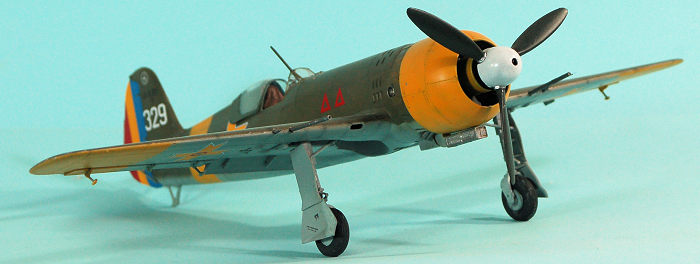 ausing them to scatter - after which "I split-essed
for the deck and executed that classic maneuver known as getting the hell out of
there. Climbing again to get over the mountains, Willsie ran across another P-38
with an engine out. "He looked pretty badly shot-up, with several large holes in
the airplane. I could tell from his markings he was from the First, but when I
tried to contact him, his radio was out. I pulled ahead of him and motioned for
him to follow me. He gave me a thumbs-up, and I led us back to Foggia, which
seemed longer than it really was, since I was waiting for either of us to loose
our good engine."
ausing them to scatter - after which "I split-essed
for the deck and executed that classic maneuver known as getting the hell out of
there. Climbing again to get over the mountains, Willsie ran across another P-38
with an engine out. "He looked pretty badly shot-up, with several large holes in
the airplane. I could tell from his markings he was from the First, but when I
tried to contact him, his radio was out. I pulled ahead of him and motioned for
him to follow me. He gave me a thumbs-up, and I led us back to Foggia, which
seemed longer than it really was, since I was waiting for either of us to loose
our good engine."
June 10, 1944, would go down in history as the blackest day in the combat history of the P-38 Lightning, with a 30 percent loss among the attackers - the worst losses suffered during a single mission by American fighters in the Second World War. It was the best day in the combat history of the IAR-81. The Rumanian claims of 51 American fighters shot down was more than twice the actual loss, but 23 P-38s failed to return to their bases around Foggia. American claims of 33 were also more than double the actual Rumanian loss of 14 - only ten of which were fighters. The high rate of over-claiming by both sides is indicative of the intensity of the battles that raged over Ploesti that day. Most importantly - despite all the sacrifice - the Romano-Americana refinery suffered no serious damage.
| THE KIT |
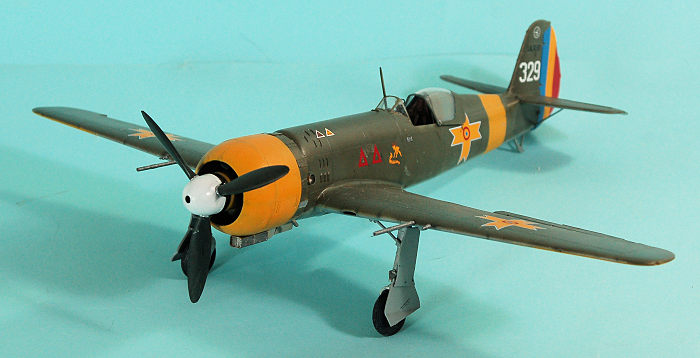 This is the Azur-FRROM IAR-81C kit originally released in 2014, now
re-released by Special Hobby. Given the enthusiast background of the kit (FRROM
being Romanian), this is likely the most accurate kit out there of the only
indigenously-developed Romanian fighter to see combat. The Special Hobby release
has everything the original released had as regards decals, photo-etch and resin
parts. The primary value of this release is that if you managed to miss the
original release, which is no longer available, you now have a second chance.
This is the Azur-FRROM IAR-81C kit originally released in 2014, now
re-released by Special Hobby. Given the enthusiast background of the kit (FRROM
being Romanian), this is likely the most accurate kit out there of the only
indigenously-developed Romanian fighter to see combat. The Special Hobby release
has everything the original released had as regards decals, photo-etch and resin
parts. The primary value of this release is that if you managed to miss the
original release, which is no longer available, you now have a second chance.
The Azur-FRROM release was reviewed in detail by Scott Van Aken when he built one after the kit came out. I strongly advise anyone interested in building this kit to review that article here at M2. My primary takeaway from the review was the things I wouldn’t be doing.
| CONSTRUCTION |
After reading Scott’s review and examining the parts for the engine - which is indeed “a model itself” - I decided that since the final result is practically invisible once it’s inside the cowling, that I was not going to invest a lot of energy in that area of the model. I ended up giving it a basic assembly and leaving it alone - it’s so far back in the cowling that you have to shine a light inside to see anything, and even then what you see is minimal. Do be sure to sand down the engine once it is assembled, so it will fit inside the cowling.
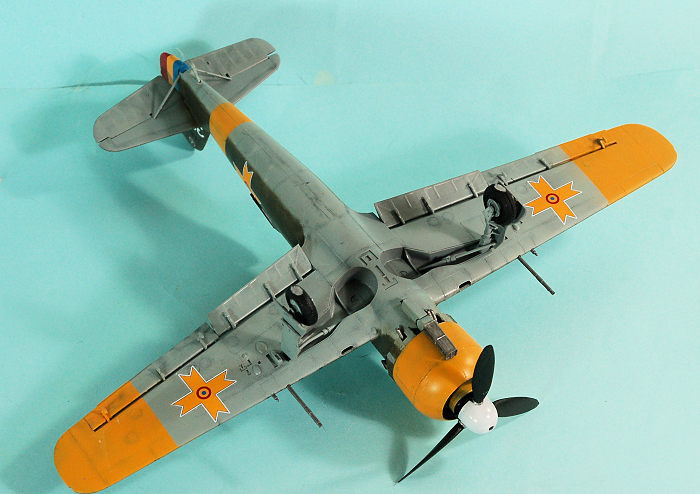 I put my primary detail effort into the cockpit, since that is very
visible in the completed model. All of Scott’s complaints about the broken
detail parts in the original release hold true here. I glued the broken parts
back together, then assembled them. I used Tamiya “Light Blue” (RLM 65) for the
interior. The end result looks nicely busy.
I put my primary detail effort into the cockpit, since that is very
visible in the completed model. All of Scott’s complaints about the broken
detail parts in the original release hold true here. I glued the broken parts
back together, then assembled them. I used Tamiya “Light Blue” (RLM 65) for the
interior. The end result looks nicely busy.
The wing was assembled with the flaps lowered. I found I needed to clean off flash from detail parts and test fit and trim the small parts to get a good fit. The horizontal stabilizers were assembled with the elevators drooped.
The only place I found I needed any filler was along the fuselage centerline and the joints of the one-piece lower wing-to-fuselage area. Careful assembly (test thrice before gluing once) got the fit as close as possible, thus needing less filler, with the result that I didn’t lose much of the very nice surface detail on the model.
I assembled the basic engine and the cowling, and left that off till after painting was complete. I found the exhaust fit poorly, so cut off the parts that can’t really be seen and glued the end of the exhausts on either side of the forward fuselage. I did glue the separate air filter in place before painting.
I made one horrid mistake, managing to drop the clear plastic canopy and find it through the CRUNCH sound it made when I stepped on it during my search for it. Special Hobby is very good about replacing missing or broken parts, you just have to wait for the mail to get them to you. While waiting for that, I went on and finished the model in anticipation of the replacement canopy.
| COLORS & MARKINGS |
I chose the decal option for an airplane that would likely have seen
combat against the P-38s on June 10, 1944. I first pre-shaded the model with
flat black, then I mixed some Tamiya flat yellow with some flat red to get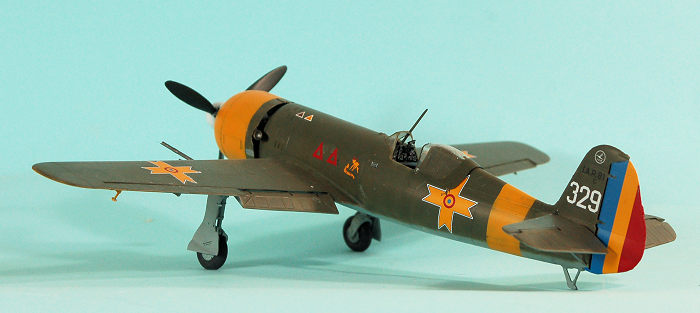 a
color that was close to the yellow sections of the insignia, then painted the
cowling, the underside of the wingtips and the fuselage band, after first
covering the area with flat white. I masked those off and proceeded to do the
simple camouflage scheme of RLM 65 lower surfaces and a color close enough to
RAF Dark Green that I used Tamiya RAF Dark Green to do it. I post-shaded the
upper surface to simulate sun-fading. The detail in the air filter was “popped
out” by applying Tamiya “Smoke” once it was painted.
a
color that was close to the yellow sections of the insignia, then painted the
cowling, the underside of the wingtips and the fuselage band, after first
covering the area with flat white. I masked those off and proceeded to do the
simple camouflage scheme of RLM 65 lower surfaces and a color close enough to
RAF Dark Green that I used Tamiya RAF Dark Green to do it. I post-shaded the
upper surface to simulate sun-fading. The detail in the air filter was “popped
out” by applying Tamiya “Smoke” once it was painted.
Special Hobby decals are commendably thin, which can create problems when applying them. Get them to the point where they are just about ready to float off, then apply lots of water to the surface where you intend to apply them, since they will stick where they first touch the model otherwise. Once in position, I wicked up the excess water with a tissue, then applied a light coat of Solvaset, which snuggled the decal down without further problem.
To call the landing gear “fiddly” is an understatement. I ended up attaching everything with cyanoacrylate to get it into proper position. Once the replacement canopy arrived, I painted it and attached it in the open position.
| CONCLUSIONS |
This is a nice kit that gives an accurate result. It is a limited-run kit, so bear that in mind. If you take your time and follow the very good instructions, you’ll have a nice model of a little-known but important aircraft of the Second World War, an airplane whose under-rated pilots were able to give a bunch of P-38 drivers the fright of their lives.
2 August 2018
Copyright ModelingMadness.com
Review Kit courtesy Special Hobby.
If you would like your product reviewed fairly and fairly quickly, please contact the editor or see other details in the Note to Contributors.
Back to the Main Page Back to the Review Index Page Back to the Previews Index Page